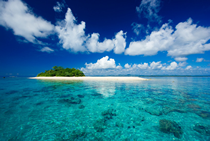CARIBBEAN

The Caribbean is an area that mostly includes the Caribbean Sea and its surrounding islands. It is located south-east of the Northern America and Gulf of Mexico, to the north of South America and to the east of Central America. The population in 1800 is estimated to reach 2.2 millions. Immigrants from China, India, and other regions arrived in the nineteenth century. After the termination of the Atlantic slave trade, its population increased naturally. By 2000, the entire regional population was approximately 38 million.
Most of the Caribbean population is of African ancestry, there are also mixed-race minorities, while people of European ancestry are mainly Portuguese, French, English and Dutch ancestry.
Asians, especially those of Indian and Chinese descent, is a significant minority in the Caribbean and also contribute to multi-racial communities.The Spanish-speaking Caribbean states essentially have mixed race, European, or African majorities. The Dominican Republic has a mixed race of Native, European, and African as majority; Cuba and Puerto Rico are mostly composed of European descendants.
The Caribbean region, located mostly in the tropics, stretches out in a broad arc of more than 4000 km from the Bahamas to the north, Suriname and Guyana to the south. The countries in the Caribbean are widely different in physical and geographical conditions. Apart from the Bahamas, many other Caribbean countries experience humid, warm conditions. The Caribbean experiences the northeasterly trade winds, which carries moisture from the Atlantic. Temperatures in this region are usually stable at about 28 degrees Celsius in the summer (July - August) to about 24 degrees Celsius in winter. The Caribbean region usually experiences stormy weathers. The weather patterns are often formed on the West Africa coast and move swiftly westwards to the Caribbean. The hurricanes usually occur between June and November
There are between two to twelve hurricanes annually. Hurricanes may be accompanied with drizzle to heavy rainfall. However, wind speed can be fairly severe, many times traveling at 100 km/h or more. Hurricane tracks, under normal circumstances move across the Caribbean towards southern part of Mexico and USA. However, they may abruptly change in severity, wind speed and direction, without warning.
The island of Cuba is the largest island in this region at 1,200 km long and it’s also the 16th largest island in the world. Today, Cuba welcomes visitors from around the world, and particularly Canada, Germany, the Great Britain, Spain, Mexico, France and Italy. Each year, more than 25,000 Americans visit Cuba, although the official U.S. foreign policy doesn't allow US citizens to travel there. Americans frequently reach Cuba from Montreal, Toronto or Cancun. Cuban immigration officers don't stamp passports so Americans are often can keep their vacations private.
Hispaniola is the second largest island in the Caribbean, containing a couple of sovereign states of the Dominican Republic and Haiti. The island lies between Puerto Rico to the east and Cuba to the west, directly in the middle of the hurricane belt.
Due to recent political problems, tourism - once an important industry - has suffered badly in Haiti , with the exception port of Labadee on the northern coast. Cruise ships often anchor offshore, and passengers disembark to the resort, frequently without being told they're in Haiti. Attractions include traditional Haitian dance performances, Haitian Flea Market, watersports, a waterpark and numerous beaches.
Tourism is important for the Dominican Republic's economic growth. In 2008, the contribution of tourism and travel to employment is expected to reach half a million workers. With the project constructions like Cap Cana, Moon Palace, San Souci Port, the country expects larger tourism activity. Eco-tourism is an increasingly influential industry in the nation, with towns like Constanza and neighboring Jarabacoa, and locations like the Bahia de Las Aguilas, Pico Duarte, and others becoming more important in tourism efforts.
For families, they often choose the Bahamas, with its comfortable resorts catering to family-recreational activities such as boating, water sports, and supervised kids' activities. While Aruba , with its hospitable natives and many resort adventure choices, is also a first-rate family destination. Aruba's Palm Beach is popular with families because of that gentle surf and plenty of water sports. Those who wish to experience the past should consider visiting St. Kitts and Nevis to see haunted plantations, old forts, and vintage railroad. Gold Coast in Barbados is well-known for its vast expanse of beautiful sandy beaches with turquoise waters, home to pleasant luxury resorts which emphasize on family activities.
Accommodation in the Caribbean , especially the resorts are great for couples, families, and groups. The surrounding is breathtaking, from white soft sandy beaches to the warmest and deepest blue seas - it is a holiday that will guarantee to impress everyone. On each Caribbean resort, you will get a number of lodging options, which allow you to find the one that suits your preference. People have often claimed that they've felt the true elements and experiences of the Caribbean while staying in a resort.
BEST DEALS :
Spend vacation in luxurious rooms and suites beneath the Caribbean sun with Beaches Resort. Save up to 65% now.
